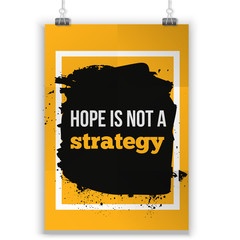The sentence hung in the air of the board room of the executive leadership team trying to evolve their business strategy.
business strategy.
"Well, we are getting beat on innovation by two competitors, our customer service scores are the lowest in the industry, and our cost structures and operational effectiveness metrics are also the worst in the industry. In order for us to stay out of bankruptcy, we've got to slash prices, cut costs, and hope that our competitors make some sort of mistake.
The other members of the leadership team thought about it for a few moments, pondered the impending doom, and quickly agreed and aligned around the business strategy of "hope."
But hope is not a business strategy.
A business strategy is a well-designed plan of action that aligns an organization around delivering a value proposition to their target customer better than competitors.
The story of course wasn't happening in a real-life board room and the participants in the conversation were high potential leaders learning about business acumen in particular strategy, finance, and business leadership. This specific team was comprised of really smart engineers, scientists, and operations experts who were chosen for the learning experience because of their upside; not because they had a lot of business acumen.
In order to help them learn-by-doing and to develop business acumen skills, our team of facilitators provided a simple guideline to help them realize that hope was not a business strategy. I share this lesson as part of today's blog...

Eight Steps for Evolving your Business Strategy from Hope to Results
1. Understand who the customers are and what they need
It all starts with the markets and the customers. Who are they? What are their buying styles, needs, and demographics? The solution: Review market forecast data, Voice of Customer data, and quantify the current and future market segments.
2. Assess your current state
Take a brutally honest look at the current state of the strategy, business, and all metrics of performance. Use tools like the SWOT Analysis, Product Portfolio Analysis, and customer feedback data.
3. Choose the right value proposition
A value proposition to your customers is the core of essence of your business strategy and sustainability. A value proposition should clearly establish in a proactive way how your organization differentiates from competitors and creates value for your selected customers.
4. Develop the solution (products/services)
Once the value proposition has been determined, organizations need a "value dashboard" that quantifies the levels of value they are going to put into their product/service. A typical value dashboard defines pricing, quality, reliability, service, green, and other similar solution characteristics.
5. Create the message
After the value proposition and the value dashboard have been developed, the next step is creating the message. The message has to include a tagline, a visual image, and an execution strategy including traditional and digital media tactics.
6. Lead the business
Once the message is developed and deployed, effective leaders execute the strategy through proactive leadership tools and techniques such as understanding personality styles of internal and external associates and partners, utilizing influence skills, delegating responsibilities, and having hard conversations.
7. Create alignment
One of the most important parts of Business Leadership is creating alignment around the execution of strategy. Alignment is another proactive behavior that anticipates pushback, embraces change, and gains agreement on the right business decisions that execute the strategy.
8. Measure your success
How do you know if your strategy works and is not just hope masquerading as a plan? You have to measure success. Success can be measured in terms of Net Promoter Scores, Voice of Customer data, financial results, market share, and shareholder value.




